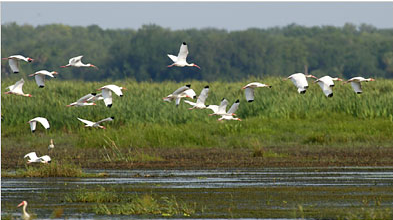Little progress has been made in restoring the Everglades and the fragile ecosystem continues to be degraded as projects with the greatest potential benefits are put off, a congressionally mandated report released Thursday found.
The fourth biennial review by the National Research Council says that while notable progress in the construction of restoration projects has been made since its last report, those initiatives still have done little to reverse generations of decline.
“Unless near-term progress is made to improve water quantity and restore water flow, ecosystem losses will continue, many of which would require decades to centuries to recover,” said William Boggess, chair of the NRC committee that wrote the report and a professor at Oregon State University.
Since development began on the vast Everglades in the late 19th century, damage has been rampant with the draining of swamp land, the erection of dikes, dams and canals, and the intrusion of farms and development that have polluted with fertilizers and runoff.
The 228-page review looked at all aspects of progress of the Comprehensive Everglades Restoration Plan, or CERP, which was approved by Congress in 2000 and originally estimated to cost about $7.8 billion, a price tag that has since ballooned.
The plan aims to restore natural water flow, but has been stymied by years of funding shortfalls, legal challenges and political bickering. The Everglades, meantime, continues to be depleted, now occupying about half its historical size of 4 million acres.
CERP calls for a 50-50 cost share between the state and federal governments. The NRC’s report says Florida’s spending since 2002, however, has far outpaced that of Washington’s, at $3.1 billion compared with $854 million.
In a joint statement Thursday, the Florida Department of Environmental Protection and the South Florida Water Management District, which leads Everglades restoration efforts for the state, pledged to work toward the goals outlined in the report.
“We will continue to work with our federal partners to fast-track project planning in the central Everglades, better integrate water quality and water quantity components and construct projects that will return the flow of cleaner water to this national treasure,” it said.
In assessing the state of ten key attributes of the Everglades, the outlook was dire. Three measures of phosphorous levels appeared to be stabilizing, though full recovery was rated as being anywhere from years to centuries away. The condition of seven other aspects of the ecosystem were rated with letter grades of two C’s, four D’s and an F, with two criteria listed as stable and the others degrading.
Progress on a key factor in reversing damage, restoring water flow to the Everglades, was rated poor.
“Twelve years into the CERP, little progress has been made on restoring the hydrology,” the authors wrote.
Bits of praise were sprinkled through the report, including for the Central Everglades Planning Project, which was called “an important step forward.” But in sum, it echoed the cries of countless Everglades advocates, who say progress is too slow and funding too small.
“We thought this problem would be fixed,” said David Guest, an attorney for Earthjustice who has spent decades fighting for Everglades restoration. “In 1994, we were screaming bloody murder that it was going to take 12 years and here we are 18 years later and we’re nowhere near solving the problem.”
The report notes funding has been strained by the recession, though Guest says getting the money has always been a problem.
“Part of it is the recession, but part of it even before that was that they didn’t make it a priority,” he said.
This article is courtesy of MATT SEDENSKY of Huffington Post
Source:
Sedensky, Matt. “Everglades Restoration: Federal Report Shows Little Progress, Dire Outlook.” The Huffington Post. TheHuffingtonPost.com, 21 June 2012. Web. 22 June 2012. <http://www.huffingtonpost.com/2012/06/21/everglades-restoration-fe_n_1615850.html?utm_hp_ref=green>.







